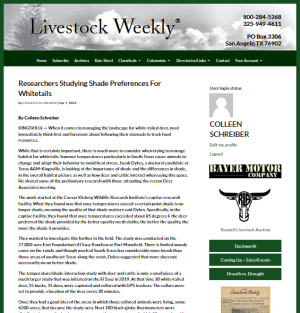
Researchers Studying Shade Preferences For Whitetails

KINGSVILLE — When it comes to managing the landscape for white-tailed deer, most immediately think first and foremost about following their stomach to track food resources.
While that is certainly important, there is much more to consider when trying to manage habitat for whitetails. Summer temperatures particularly in South Texas cause animals to change and adapt their behavior to avoid heat stress. Jacob Dykes, a doctoral candidate at Texas A&M-Kingsville, is looking at the importance of shade and the differences in shade, in the overall habitat picture as well as how deer and cattle interact when using this space. He shared some of the preliminary research with those attending the recent Deer Associates meeting.
The work started at the Caesar Kleberg Wildlife Research Institute’s captive research facility. What they found was that once temperatures exceed a certain point shade is no longer shade, meaning the quality of that shade matters said Dykes. Specifically, in the captive facility, they found that once temperatures exceeded about 85 degrees F the deer preferred the shade provided by the better-quality mesh cloths; the better the quality, the more the shade it provides.
They wanted to investigate this further in the field. The study was conducted on the 27,000-acre East Foundation’s El Sauz Ranch near Port Mansfield. There is limited woody cover on the ranch, and though much of South Texas has considerably more brush than those areas of southeast Texas along the coast, Dykes suggested that more does not necessarily mean better shade.
The temperature/shade interaction study with deer and cattle is only a small piece of a much larger study that was initiated on the El Sauz in 2019. At that time 30 white-tailed deer, 15 bucks, 15 does, were captured and collared with GPS trackers. The collars were set to provide a location of the deer every 30 minutes.
Once they had a good idea of the areas in which those collared animals were living, some 6200 acres, that became the study area. Next 100 black-globe thermometers were distributed across the landscape to measure the temperature of which 80 were placed in some type of woody cover and the remaining 20 in open grassland areas. All were placed 19 inches above ground level or about shoulder height to a whitetail. The apparatus measured operative temperature every 30 minutes. Dykes explained that operative temperature is dictated not only by the ambient air temperature but also by the effects of radiant heat from the sun and the convective cooling effects of the wind.
"Operative temperature is a more accurate representation of what animals are experiencing in a given area,” he explained.
Next, a mean temperature was determined for morning, midmorning, midday afternoon, evening and night. They then wanted to evaluate how operative temperature and the various vegetation features are influencing movement and space used by whitetails.
Some of what they’ve learned is that deer are selecting the woody cover during midday. Investigating further, they found that males selected woody cover over open grassland areas midday more than the females. In fact, the females did not show a preference.
Dykes reasoned that it may be that during July, when this study was being conducted, does are in late gestation and then lactation, both very stressful events that require lots of energy. “Perhaps it’s more of a ‘have to’ situation for the does whereas the bucks can afford to lay around and be lazy in the shade,” he told the group.
They did find that as the operative temperatures changed in one shelter, they tended to move until they found one that was cooler. “They were altering their behavior to seek out the cooler areas as they became available,” said Dykes.
In terms of overlap between cattle and the deer, based on GPS locations, they found that the deer’s core area encompassed about 624 acres while the cattle’s core area was about 1020 acres. This indicated about 390 acres of overlap.
In that overlap, the cattle and the deer were using the same shade trees in the various mottes, though the closest they ever came to each other was midmorning. However, they were on average, 1000 yards apart, Dykes said. He also noted that the cattle and the deer were more active at different times of the day.
From a management perspective, he told participants all of this should be considered when planning brushwork. Specifically, preserve those areas with high-quality shade.
“Maintaining body temperature is extremely energetically costly,” he reiterated. “This is just one more metric to consider to help alleviate animal stress so that fawn recruitment and even antler growth can be at its best.”
Finally, Dykes said that more is to come. With some 700,000 GPS locations collected, researchers expect to learn much more. They’re using Light Detection and Ranging, LIDAR, a remote sensing method to look at vegetation density and height to ease out again the better types of shade. Additionally, researchers are looking further into how does and bucks use the landscape differently and why. Also learning they’re working on learning more about why one bedding site is chosen over another or which bedding site, based on various parameters, is better than another.
This type of research may also apply to other management efforts. For example, they may be able to identify specific species of brush that are providing better shade for the deer and perhaps incorporate what they’ve learned about where the deer congregate to improve on the best locations to treat deer for cattle fever ticks, he concluded.